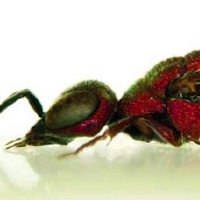The case of Holopyga gogorzae Trautmann, 1926 and revision of the H. miranda group (Hymenoptera, Chrysididae)

All claims expressed in this article are solely those of the authors and do not necessarily represent those of their affiliated organizations, or those of the publisher, the editors and the reviewers. Any product that may be evaluated in this article or claim that may be made by its manufacturer is not guaranteed or endorsed by the publisher.
Authors
The species treated as Holopyga gogorzae Trautmann, 1926 by Linsenmaier (1959) and subsequent authors was found to be misidentified. The first available name for this West Mediterranean species, thus the valid one, is Holopyga calida Linsenmaier, 1951, herewith raised to specific rank. Surprisingly enough, the true H. gogorzae Trautmann, whose female is still unknown, does not belong to the H. miranda group; it conversely belongs to the H. fervida group, and is most closely related to H. rubra Linsenmaier, 1999 according to genital capsule and tarsal claws. A key to the species of the H. miranda group, and relevant illustrations, are here provided. During this study, Hedychridium planatum Bischoff, 1910 and H. planatum var. auratum Bischoff, 1910 both proved Holopyga, not Hedychridium, most likely synonyms of H. fervida (Fabricius, 1781). The name Holopyga amoenula group is here proposed to replace the name Holopyga gloriosa group given by Linsenmaier (1959), because the name gloriosa Fabricius, 1793 has been suppressed by the ICZN - International Commission on Zoological Nomenclature (1998) and is therefore invalid.
How to Cite
PAGEPress has chosen to apply the Creative Commons Attribution NonCommercial 4.0 International License (CC BY-NC 4.0) to all manuscripts to be published.










